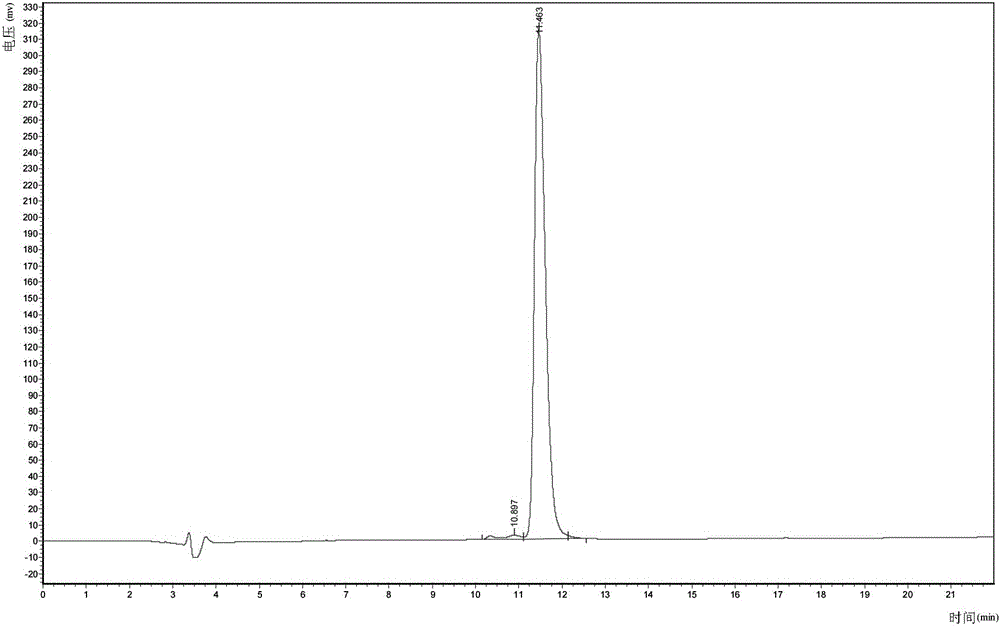Method for separation of palmitoyl pentaspeptide-3 by high performance liquid chromatography
A high-performance liquid chromatography, palmitoyl pentapeptide technology, applied in material separation, analysis materials, measuring devices and other directions, can solve problems such as large consumption, reduce pollution and improve separation and purification efficiency.
- Summary
- Abstract
- Description
- Claims
- Application Information
AI Technical Summary
Problems solved by technology
Method used
Image
Examples
Embodiment 1
[0015] 1. Sample treatment: add a little methanol to palmitoyl pentapeptide-3 and sonicate until the liquid is clear, filter through a filter membrane with a pore size of 0.45um and collect the filtrate for later use.
[0016] 2. Purification
[0017] Purification conditions: Chromatographic column: C4 chromatographic column, column diameter and length: 5cm×25cm. Mobile phase: Phase A: chromatographically pure acetonitrile; Phase B: 0.1% mass percent concentration of trifluoroacetic acid in methanol. Flow rate: 60-80ml / min. Detection wavelength: 230nm. Gradient: A%: 5%-70%, 30-50min. The injection volume is 3-5g.
[0018] Purification process: equilibrate the chromatographic column with 5% phase A and load the sample, the sample volume is 1-2.0L sample solution. Linear gradient elution, collect the target peak, and put the collected peptide solution in the collection bottle for later use.
[0019] 3. Salt conversion: Rinse the reversed-phase silica gel column with C4 as ...
Embodiment 2
[0022] 1. Sample treatment: add a little methanol to palmitoyl pentapeptide-3 and sonicate until the liquid is clear, filter through a filter membrane with a pore size of 0.45um and collect the filtrate for later use.
[0023] 2. Purification
[0024] Purification conditions: chromatographic column: C4 chromatographic column, column diameter and length: 5cm×25cm. Mobile phase: A phase: chromatographically pure acetonitrile; B phase: 0.1% mass percent trifluoroacetic acid ethanol solution. Flow rate: 60-80ml / min. Detection wavelength: 230nm. Gradient: A%: 5%-70%, 30-50min. The injection volume is 3-5g.
[0025] Purification process: equilibrate the chromatographic column with 5% phase A and load the sample, the sample volume is 1-2.0L sample solution. Linear gradient elution, collect the target peak, and put the collected peptide solution in the collection bottle for later use.
[0026] 3. Salt conversion: Rinse the reversed-phase silica gel column with C4 as the stationa...
Embodiment 3
[0029] 1. Sample treatment: add a little methanol to palmitoyl pentapeptide-3 and sonicate until the liquid is clear, filter through a filter membrane with a pore size of 0.45um and collect the filtrate for later use.
[0030] 2. Purification
[0031] Purification conditions: chromatographic column: C8 chromatographic column, column diameter and length: 10cm×25cm. Mobile phase: A phase: chromatographically pure acetonitrile; B phase: 0.1% mass percent trifluoroacetic acid methanol solution. Flow rate: 160-200ml / min. Detection wavelength: 230nm. Gradient: A%: 5%-70%, 30-50min. The injection volume is 10 -15g.
[0032] Purification process: equilibrate the chromatographic column with 5% phase A and load the sample, the sample volume is 3-5L sample solution. Linear gradient elution, collect the target peak, and put the collected peptide solution in the collection bottle for later use.
[0033] 3. Salt conversion: Rinse the reversed-phase silica gel column with C8 stationary...
PUM
| Property | Measurement | Unit |
|---|---|---|
| wavelength | aaaaa | aaaaa |
Abstract
Description
Claims
Application Information
 Login to View More
Login to View More - R&D
- Intellectual Property
- Life Sciences
- Materials
- Tech Scout
- Unparalleled Data Quality
- Higher Quality Content
- 60% Fewer Hallucinations
Browse by: Latest US Patents, China's latest patents, Technical Efficacy Thesaurus, Application Domain, Technology Topic, Popular Technical Reports.
© 2025 PatSnap. All rights reserved.Legal|Privacy policy|Modern Slavery Act Transparency Statement|Sitemap|About US| Contact US: help@patsnap.com

